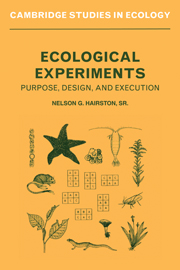Book contents
- Frontmatter
- Contents
- Preface
- Acknowledgments
- 1 Ecological problems and how they are approached
- 2 Minimal requirements of experimental design in ecology
- 3 Trade-offs in ecological experimentation
- 4 Experiments in forests
- 5 Experiments in terrestrial successional communities
- 6 Experiments in arid environments
- 7 Experiments in fresh water
- 8 Experiments in marine environments
- 9 Conclusions to be drawn from field experiments
- References
- Name index
- Subject index
8 - Experiments in marine environments
Published online by Cambridge University Press: 05 June 2015
- Frontmatter
- Contents
- Preface
- Acknowledgments
- 1 Ecological problems and how they are approached
- 2 Minimal requirements of experimental design in ecology
- 3 Trade-offs in ecological experimentation
- 4 Experiments in forests
- 5 Experiments in terrestrial successional communities
- 6 Experiments in arid environments
- 7 Experiments in fresh water
- 8 Experiments in marine environments
- 9 Conclusions to be drawn from field experiments
- References
- Name index
- Subject index
Summary
Introduction
Unlike experiments undertaken in terrestrial situations, or in lakes or ponds, the logical orientation in marine locations deals less with trophic position than with exposure to wave action and the nature of the substrate. Herbivory and predation do indeed play important roles in some marine locations, but producers, filter feeders, and sessile predators have been found to compete for space in various combinations, making the classical trophic level organization less basic to understanding the ecology of marine shores, where nearly all of these experiments have taken place.
The nature of the substrate has provided the most convenient basis for dividing experiments into groups, rocky shores and areas with soft sediments (either sand or mud) being the two principal types. All experiments on soft bottoms have taken place in protected bays or marshes, because it is not feasible to conduct experiments on wave-swept beaches.
Rocky shores
The favorite environment in which experiments have been conducted has been the rocky coast. For readers not familiar with rocky shores, such as those living south of New York on the Atlantic Coast of the United States, there are many books describing the habitats, such as Rickets and Calvin (1968) and the beautiful volume by Wertheim (1985). Here, there are vertical levels that may determine the possible array of species. At the highest level, the rock may become wet only because of breaking waves – not actually covered by the tide at all.
- Type
- Chapter
- Information
- Ecological ExperimentsPurpose, Design and Execution, pp. 260 - 315Publisher: Cambridge University PressPrint publication year: 1989

